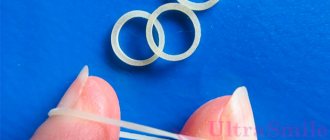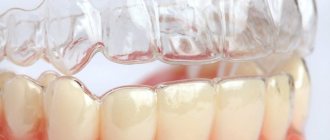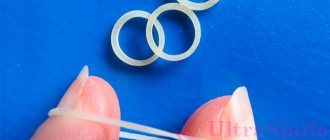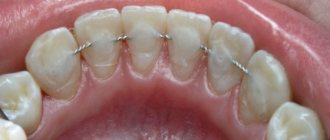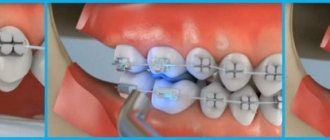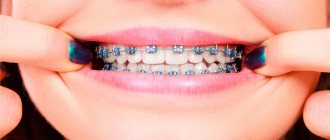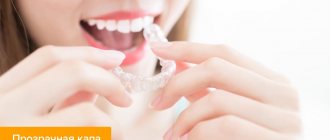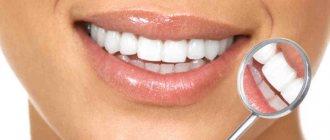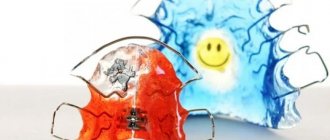5738
Braces are the design most often used to correct malocclusion in adolescents. Wearing such a device causes a lot of negativity in children, since the elements of the system stand out strongly on the teeth.
To solve this problem, dentists suggest installing colored braces, which are distinguished by their unusual and creative appearance.
What colored braces look like
In fact, to get a fun color scheme and a variety of shades, doctors use regular classic braces with colored rubber bands, called ligatures. Those. It is not the plates themselves that have a bright tint, but the colored ligatures that act as fixatives for the metal arc in the grooves of the system. In appearance, they resemble rings made of elastic material and can have different diameters and thicknesses. With their help, orthodontists achieve the desired effect of transforming classical systems beyond recognition, creating a bright, individual and unique image that many children and even some adults like so much.
When using self-ligating or non-ligating systems, this effect will no longer be achieved. It is also inappropriate to use ligatures on lingual orthodontic appliances, which are fixed on the inner lingual side of the dentition, because they are invisible to others.
On a note! Currently, the choice of colored braces is very wide and varied. Most often, to give the desired shade, doctors choose rubber bands or ligatures that match the color. However, today some manufacturers produce systems, for example, made of plastic, in which the plate brackets themselves are painted in different colors. Ligatures can have not only different colors, but also various shapes: hearts, diamonds, flowers.
The staples are attached with a special adhesive to the surface of the tooth, from the front side (vestibular). A restoring arch in the form of a wire is pulled through the brackets, and elastic bands serve to prevent movements of the arch in the hole of the bracket. See what braces with colored rubber bands look like in the photo.
Types of bracket systems
Braces are no longer the bulky systems that were used in the last century. Today, braces are miniature and almost invisible. They are attached to the teeth with orthodontic glue. Each element has a groove into which the arc fits. It has a “memory of a given shape”. Arch resistance is the force that works to align the teeth. Gentle pressure is constantly applied to each tooth in the desired direction.
We install systems that differ in various parameters: the material used to make braces, the location of their installation and the method of attaching the arch to them.
What are ligatures
Ligatures, which can be colored, are designed to secure the arches to the staples. Some people also mistakenly call them elastics or traction bands, but other types of elastic bands have these names. Thus, traction bands or elastics, unlike ligatures, are larger in size and have excellent stretch; they are designed for additional tightening of individual teeth. Also, unlike ligatures, the patient can independently remove them from the mouth at home in order to eat or perform oral hygiene, but ligatures cannot be removed independently - this must be done by the orthodontist.
Main features and purpose of color systems
Colored braces, as in the photo, differ from ordinary classic ones in that they almost completely cover and disguise the metal arches, and only the locking parts of the system remain open. This feature allows young patients to feel more confident and free from psychological discomfort. Such devices look like a decorative element on the teeth and allow you to create an individual image that will be the envy of other teenagers, which is very important for a child undergoing quite complex orthodontic treatment.
Important! Regardless of what material the braces are made from, they all have a metal arch. The arch itself can also be painted white for aesthetics, but it is important to remember that the top paint may peel off during use due to friction that occurs when the teeth move in a given direction. This factor may slightly increase the treatment time, which is why many patients prefer to leave the metal arch unpainted.
Otherwise, colored braces for children are no different from other models; they have an orthodontic arch that is located above the teeth and moves them in a given direction. They also allow you to correct and correct malocclusions of any complexity.
How to care for aesthetic braces
During orthodontic treatment, it is necessary to periodically perform professional oral hygiene. This will improve the appearance of the teeth and the system itself. After cleaning, braces shine with a special pristine whiteness.
The patient needs to brush his teeth two to three times a day. It is better to ask your dentist in advance about which toothpaste is best to use when wearing a denture. Your doctor will advise you on how to care for your braces.
If you wear braces, you will have to avoid eating too much solid food.
– nuts, apples, etc. Solid food can damage the system and cause structural deformation. To preserve the original color of the structure, it is better not to consume bright red and orange juices. You should avoid coffee and strong tea. Ceramic braces have proven themselves well in care - the material from which the structures are made does not lend itself to pigmentation.
What materials are used to make braces that children love so much?
Colored rubber bands can be used on braces made of any classic materials.
Metal
Metal braces will also become colored if ligatures of different shades are fixed to them. Gray metal devices themselves cause little delight in children, but they correct malocclusions better and a little faster than others (due to the low coefficient of friction between the walls of the groove and the arch). In addition, these structures are very wear-resistant and durable, and if colored ligatures are attached to them, they will look more original and attractive. But remember that metal devices can contribute to the development of allergies in children who are prone to allergic reactions.
Plastic
The plastic is transparent, but if you complement it with colored ligatures, the image will turn out bright and practical. The material is good for children due to its safety and minimal risk of developing allergic reactions, but it can be stained by food, and bright elastic bands will make the change in shade less noticeable and conspicuous.
Plastic systems also have several significant disadvantages: they are often subject to breakdowns and are not suitable for correcting serious malocclusions.
Ceramics
Ceramics are more often chosen by adults than children, but, for example, adolescents who are in puberty, especially girls, often prefer aesthetic and invisible systems. Ceramics are similar in color to natural enamel and have the same shine and gloss. However, even when correcting the bite with orthodontic devices made of ceramics, we must not forget that the arch that runs along the entire dentition will be made of metal. At the request of the patient, the arch can also be painted in light shades, but teenagers more often choose to “camouflage” the metal arch with the help of brightly colored ligatures, and this is how colored ceramic braces appear.
Sapphire
Ceramics and sapphire are the most aesthetic options for correcting a bite; they are almost invisible on the teeth in daylight and evening light, and in bright sunlight they shimmer like precious jewelry. Such systems, due to their high cost and greater fragility (compared to metal ones), are less often chosen for children, but nevertheless, here, too, bright elements can be used to make the image unique and memorable, which will definitely appeal to many teenagers.
Interesting! On the Internet you can often see photos where there are colored dots on the braces. Some people believe that this is also a kind of decorative element, although in fact this is not the case. These dots are nothing more than markings for orthodontists; they easily wear off and lose color after the first few procedures of hygienic oral care.
What are rubber bands on braces used for?
Doctors explain in detail why you need to wear rubber bands on braces. Usually, the attachment of elastics is indicated at the beginning of wearing braces and at the final stage of correction. Situations in which the orthodontist will install traction:
- Impacted teeth. With an incorrect bite, permanent teeth do not always erupt on time and in their places. Sometimes single teeth grow late, when their place in the jaw is already taken by other teeth. Or they grow to an incomplete size. Orthodontic traction helps to stretch the tooth and put it in the right place. To do this, a button is attached to the unit, an elastic connected to the bracket is attached to it, and they move the tooth in the desired direction. When the crown appears completely, the button is replaced with a regular bracket, and a metal arch begins to be responsible for the correction.
- Malocclusion. When correcting a malocclusion, elastics are worn at the end of treatment to align the jaw rows relative to each other. In case of distal pathology, fixation of elastic fastenings is performed symmetrically - the lower jaw is pulled towards the upper jaw. When correcting an open bite, the upper and lower teeth are pulled so that the upper incisors overlap the lower ones and disocclusion is eliminated. Using special schemes, pathologies of crossbite and mesial bite are eliminated.
Elastics are also used for proper alignment of the jaw rows relative to each other. Jaw displacement is a common intermediate stage of correction. Temporary asymmetry is caused by the return of separately growing teeth to the bite line, the elimination of teeth and diastemas, or the removal of some units. Elastics quickly eliminate local damage.
Elastic traction almost always accompanies wearing braces, so it is useful for patients to know the specifics of fixation and the features of wearing elastic bands.
Benefits of Vibrant Orthodontic Systems
- psychological comfort: do not forget that braces can be installed and worn only when baby teeth are replaced with permanent ones, which occurs at the age of 12-14 years. It is during this period that children, and especially teenagers, react very sharply to changes associated with their appearance,
- maintaining a good mood: let the child choose the colored ligatures for braces himself, choose the shade he needs - this will allow him to feel confident and maintain a good mood, which is especially important at the stage of getting used to and adapting to the orthodontic apparatus,
- the elastic bands do not change their shade: this is very important, because Not all children practice good oral hygiene. At the same time, many teenagers are no longer amenable to parental control, so in secret from moms and dads they can eat food and drink soda, which can stain not only the enamel of teeth, but also elements of braces. Due to the fact that the rubber bands are not affected by dyes, plaque and food residues are difficult to see on them, children’s smile will always look quite good,
- the presence of bright elements will have a slight impact on the cost of the braces system: this factor is pleasant for parents, because you can install quite inexpensive metal or plastic systems for children, which will be decorated with multi-colored rubber bands,
- The elastic bands are harmless: they are soft, do not have sharp edges and are painted with safe dyes (made of medical polyurethane). Even if the child swallows such a gum, nothing bad will happen - it will not injure the esophagus, will not lead to intoxication, and will leave the body naturally,
- individuality: there are no standard solutions, and each patient will have his own individuality.
Who is suitable for bright braces?
Traditionally, multi-colored braces are more common among teenagers. They do not cause psychological discomfort during communication and can create the necessary image.
For teenagers, a multi-colored braces system becomes a kind of feature, a bright accent in the image. Everyone knows that in adolescence, criticism of appearance is perceived in an aggravated form. Some teenagers even achieve popularity among their peers thanks to their colorful smile.
Also, adult patients with a developed sense of humor can wear multi-colored braces. With the help of such a bright accessory, they manage to lift the mood of themselves and those around them.
Disadvantages that not everyone knows about
Braces with colored rubber bands have a number of disadvantages, which not every patient is aware of. So, the rubber bands themselves are short-lived and wear out quickly. Accordingly, they have to be changed approximately once every 3-4 weeks. In addition, there is always the possibility that the child may swallow the ligature. It's safe, but if it happens on a regular basis, there won't be anything pleasant about it.
In some patients, the presence of rubber bands can cause problems with diction. True, in most cases the problem goes away after adaptation to braces, which, depending on the individual characteristics of the patient, can take from 2 weeks to several months.
By type of fixing element
Bracket systems differ in the method of fixing the archwire in the bracket. Based on this feature, there are two types of braces.
Ligature bracket systems are considered classic. Ligatures are the elements on which the arch is attached to the bracket (rubber bands and thin wires). The leveling structure has a smaller volume. Patients get used to it faster.
Non-ligating systems (self-ligating) are equipped with micro-locks for attaching the arch to the bracket. The design is more massive. It will take more time to get used to the appearance of “extra” elements in your mouth.
Not only the appearance of the structure depends on the presence of a small element (ligature). The speed of bite correction using non-ligature installations is slightly higher than when using ligature systems. But there are anomalies that cannot be corrected with non-ligature braces.
Which shade is better to choose
This question always arises before children and their parents, because... Today there are a lot of different options - orthodontists offer their patients more than 20 different shades. Ligatures can have any shades, ranging from white and transparent to bright red and green, turquoise, gold and purple. Some patients choose a combination of different shades (elastic bands of different shades are attached to each plate), others prefer one range - here the flight of imagination is not limited.
However, there are several factors to consider when choosing. For example, yellow is not suitable for all patients, because... it will visually make the teeth themselves even more yellowish. If a child really likes yellow, then it is better to give preference to bright yellow rather than pale yellow.
Against the background of white rubber bands, any, even the snow-white enamel (and perfectly white teeth are rare) will also give off a yellowish tint and will look duller. In addition, white elements get dirty very quickly and are stained by food, so very soon they will look unkempt.
On a note! Don’t forget that classic braces need to be activated regularly; therefore, when visiting an orthodontist, you can always choose a new shade of elastic bands or change the palette.
If a child has naturally dark enamel, then it is better to give preference to dark elastic bands (blue, black, purple, rich green, burgundy). If you want to visually make the enamel lighter, then it is advisable to choose bright colors - red, orange, turquoise. If the enamel is naturally grayish, then you need to choose warm spring shades.
Rubber bands are often chosen according to the eye color of the growing patient. So, if a child has green, gray, or blue eyes, then the elements of the system of the corresponding shade will look impressive.
The most universal shades that suit most patients are blue, red, light blue.
Interestingly, in some private clinics the palette is divided into several groups: for boys and men, for girls and for adult women.
What to consider when choosing?
Choosing a color for braces is not always an easy task.
In order for the device to make your smile unusual, and at the same time emphasize it favorably, when choosing, you need to take into account certain nuances :
- You should not install white ligatures, since even with a high degree of whiteness of the teeth, they will look a shade whiter, which means they will dull the color of the enamel.
- The selection of yellow color must be approached very carefully, since some shades can impart yellowness to white enamel or enhance its existing yellow color.
If you nevertheless opted for yellow ligatures, then preference should be given to rich colors that add brightness to the teeth; - Bright spring colors are well suited for naturally gray enamel, which will visually lighten its surface.
- You can show dark teeth in an advantageous light using ligatures of a dark shade, for example, deep blue, black, burgundy.
- You can emphasize your individuality and originality with the help of red, blue, orange or bright green ligatures that are suitable for all teeth.
- Braces matched to your eye color look very impressive.
- Adults are advised to select a shade based on their gender.
Women are more suited to delicate shades of turquoise, pink or coral.For men, a different range is defined, including pale shades of purple and blue.
- For children, it is recommended that ligatures of a different color be placed on each bracket. This will allow you to turn the fixation procedure into a game, and make the wearing process more interesting.
Despite the fact that colored ligatures are more designed for use in children, they remain in demand among adults.
In addition, most systems provide for regular activation of the device, during which you can constantly experiment by changing the color scheme of the ligatures.
Alternative to colored rubber bands
Doctors often camouflage the metal archwire by using colored wire to help make the staples themselves attractive. The wire can be created from steel or silver, titanium or aluminum. It is more wear-resistant and lasts longer compared to ligatures. However, it has one significant drawback - under the influence of drinks and food consumed, temperature changes, its outer layer can crack, which will look unaesthetic. Therefore, orthodontists still often advise choosing braces with ligatures.
Material
The main structure is made from conventional dental materials - metal, ceramics, plastic. The ligatures and rubber bands are colored, and children can also choose picture stickers for the plate itself.
Metal
The preferred material remains metal and metal alloys. Metal devices hold their shape perfectly, do not break, and are convenient for daily use. The unaesthetic appearance of the metal is brightened up by colored rubber bands placed on the staples themselves: the product looks bright and extraordinary. The rubber bands need to be changed once a month at an appointment with the orthodontist. There is no need to come specifically to change the rubber bands: the doctor will replace them during a routine examination and correct the pressure force of the system. The color of the rubber bands is chosen by the patient himself: they can be the same shade or multi-colored.
Plastic
The next material is orthodontic plastic. If earlier plastic products quickly lost their former attractiveness and were painted in the color of the food taken, then in the modern version plastic is created in color. This protects the material from staining food and gives it an elegant look. Even products made of transparent plastic, complemented with bright colored accessories in the form of elastic bands and ligatures, look attractive.
Ceramic
The best material for the manufacture of orthodontic systems, but expensive. Ceramics are always combined with the color of natural tooth enamel; only ligatures in these products can be multi-colored. The same can be said about orthodontic systems made of sapphires: they are decorated with multi-colored rubber bands that disguise the metal arch.
How to install and remove ligatures
You can improve the aesthetics of your smile even when classic vestibular braces have already been installed. To put on the elastic bands, you need to spend a little time - about 10-20 minutes. This is very convenient for children who do not want to spend a long time in the dentist's chair.
So, first, the doctor separates the pad from the clamp using a special clamp, then puts an elastic band on the bracket, and then checks the strength of the fastening. After a month of treatment, the rubber bands must be replaced with new ones. Only your doctor should remove them; under no circumstances should you do it yourself. The specialist will do this carefully, without damaging the elements of the correction system.
Features of nutrition and hygiene care
If your children wear bright orthodontic appliances, then you need to focus their attention on the fact that the elastic bands on them can change their structure, lose their bright shade and become less flexible if the patient abuses carbonated drinks and hot foods.
As for the rules of care, they are standard for all “braces” wearers: you need to carefully remove plaque not only from the teeth, but also from all elements of the bracket system (plates, clasps, arches, elastic bands), and from the interdental spaces. Special V-shaped brushes and pipe cleaners will help with this. Also, be sure to purchase an irrigator for children, which will help even those who are not very responsible about oral hygiene to better care for their teeth and devices. With the help of an irrigator, the smallest particles of food will be washed out of all hard-to-reach areas. In addition, the device will help care for your gums, provide them with a gentle massage, enhance and normalize blood circulation, and help reduce the risk of developing gingivitis and periodontitis.
It is important for parents to daily monitor the thoroughness and timeliness of hygienic care during orthodontic treatment in children, because some researchers believe that in young patients with braces, the risk of developing caries increases 13 times1 just because they brush their teeth poorly or do not do it at all .
The cost of bright solutions
How much do colored braces cost? Their cost exceeds the cost of metal ones, but much less than sapphire and ceramic ones. Treatment of malocclusion using metal devices will cost the patient from 25,000 rubles, which depends on the complexity of the case. Plastic structures cost from 30,000 rubles. When using ligatures of unusual shape, the price will increase. For colored ceramic braces, the price will already be quite high: 70,000-120,000 rubles. Designs made from artificial sapphires are even more expensive, on average 12,000 and above.
